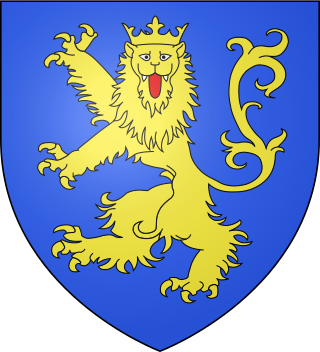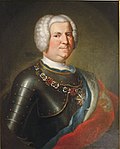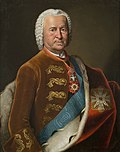Top Qs
Timeline
Chat
Perspective
House of Schwarzburg
Noble family of Thuringia, Germany From Wikipedia, the free encyclopedia
Remove ads
The House of Schwarzburg was one of the oldest noble families of Thuringia, which is in modern-day central Germany. Upon the death of Prince Friedrich Günther in 1971, a claim to the headship of the house passed under Semi-Salic primogeniture to his elder sister, Princess Marie Antoinette of Schwarzburg who married Friedrich Magnus V, Count of Solms-Wildenfels.[1][2] Reigning over the County of Schwarzburg and founded by Sizzo I of Schwarzburg (died 1160), the family split in the 16th century into the lines of Schwarzburg-Sondershausen and Schwarzburg-Rudolstadt, with the Sondershausen line dying out in 1909.
Quick facts Schwarzburg, Country ...
| Schwarzburg | |
|---|---|
 | |
| Country | Schwarzburg-Rudolstadt, Schwarzburg-Sondershausen |
| Founded | 12th century |
| Founder | Sizzo I, Count of Schwarzburg |
| Final ruler | Prince Günther Victor |
| Titles | Count, Prince |
| Deposition | 1918 |
Close

Remove ads
Family history
Summarize
Perspective
The County of Schwarzburg was a state of the Holy Roman Empire from 1195 to 1595, when it was partitioned into Schwarzburg-Rudolstadt and Schwarzburg-Sondershausen. It was ruled by counts from the House of Schwarzburg. Schwarzburg Castle was first mentioned in a 1071 deed. In 1123 Count Sizzo III of Käfernburg (Kevernburg), mentioned by the medieval chronicler Lambert of Hersfeld and according to the Annalista Saxo a grandson of Prince Yaropolk Izyaslavich of Turov by his mother, rebuilt the castle calling himself a "Count of Schwarzburg". Sizzo also established Georgenthal Abbey and in 1157, he accompanied Emperor Frederick I Barbarossa during his campaign against High Duke Bolesław IV the Curly of Poland.
In 1197, Sizzo's grandson Henry II divided the common heritage with his brother Günther III and made Schwarzburg Castle his residence. His territory then also comprised the nearby castle of Blankenburg.
The most famous family member is Günther XXI von Schwarzburg. In 1349, he was elected as German king by the majority of electors. But, due to waning support, he renounced some months later and died shortly after.
The Schwarzburg lands were again divided among his successors until in 1538 when Count Günther XL the Rich was able to unite the territories including Frankenhausen and Rudolstadt under his rule. He was succeeded by his eldest son Günther XLI. However, after his death in 1583, his younger brothers again divided the county: John Günther I received the territory around Arnstadt, later called Schwarzburg-Sondershausen, while Albrecht VII inherited the lands of Schwarzburg-Rudolstadt. The partition was finally confirmed by the 1599 Treaty of Stadtilm.
- The castle at Schwarzburg. The building is being renovated now.
- The Schwarzburg principalities in 1910Schwarzburg-RudolstadtSchwarzburg-Sondershausen
Remove ads
Rulers of Schwarzburg
Summarize
Perspective
House of Schwarzburg
Partitions of Schwarzburg under Schwarzburg rule
Note:Below it is presented a simplified organisation of the Schwarzburg lands. Some particularities of certain feuds are explained in footnotes.
| Property of the comital family of Loccum-Hallermund | ||||||||||
| County of Schwarzburg (1030-1320) |
County of Käfernburg 1st creation: 1070-1118 2nd creation: 1160-1184 | |||||||||
| County of Hallermund (1197-1411) (inherited)[3] | ||||||||||
| County of Wiehe (1223-1338) | ||||||||||
| County of Blankenburg[4] (1278-1538) |
County of Arnstadt (1st creation) (1275-1306)[5] |
County of Käfernburg[6] (3rd creation) (1223-1386) | ||||||||
| County of Leutenberg[7] (with Schwarzburg half 1) (1320-1564) |
County of Wachsenburg (with Schwarzburg half 2) (1320-1461) |
County of Arnstadt (2nd creation) (1324-1357)[8] | ||||||||
| County of Sondershausen (1st creation) (1338-1390) |
Annexed to Weimar- Orlamünde | |||||||||
| County of Schwarzburg (half 1) (1358-1399) |
County of Schwarzburg (half 2) (1355-1450[9]) |
County of Wachsenburg (1320-1406) |
||||||||
| Annexed to Meissen | ||||||||||
| County of Leutenberg (1320-1564) |
(Sondershausen line from 1390) | |||||||||
| Sold to Brunswick- Lüneburg | ||||||||||
| County of Sondershausen (2nd creation) (1476-1537) |
County of Arnstadt (3rd creation) (1488-1564)[10] |
|||||||||
| County of Schwarzburg (1564-1571) (Arnstadt line) | ||||||||||
| County of Frankenhausen (1571-1597) |
County of Rudolstadt (1571-1710) |
County of Sondershausen (1571-1697) |
County of Arnstadt (5th creation) (1571-1697)[11] Raised to: Principality of Arnstadt (1697-1716) | |||||||
| Raised to: Principality of Rudolstadt (1710-1909) |
Raised to: Principality of Sondershausen (1697-1909) | |||||||||
| Principality of Schwarzburg (1909-1918) (Rudolstadt line) | ||||||||||
More information Table of rulers, Ruler ...
Table of rulers | |||||||||||||||||||||||||||||||||||||||||||||||||||||||||||||||||||||||||||||||||||||||||||||||||||||||||||||||||||||||||||||||||||||||||||||||||||||||||||||||||||||||||||||||||||||||||||||||||||||||||||||||||||||||||||||||||||||||||||||||||||||||||||||||||||||||||||||||||||||||||||||||||||||||||||||||||||||||||||||||||||||||||||||||||||||||||||||||||||||||||||||||||||||||||||||||||||||||||||||||||||||||||||||||||||||||||||||||||||||||||||||||||||||||||||||||||||||||||||||||||||||||||||||||||||||||||||||||||||||||||||||||||||||||||||||||||||||||||||||||||||||||||||||||||||||||||||||||||||||||||||||||||||||||||||||||||||||||||||||||||||||||||||||||||||||||||||||||||||||||||||||||||||||||||||||||||||||||||||||||||||||||||||||||||||||||||||||||||||||||||||||||||||||||||||||||||||||||||||||||||||||||||||||||||||||||||||||||||||||||||||||||||||||||||||||||||||||||||||||||||||||||||||||||||||||||||||||||||||||||||||||||||||||||||||||||||||||||||||||||||||||||||||||||||||||||||||||||||||||||
|---|---|---|---|---|---|---|---|---|---|---|---|---|---|---|---|---|---|---|---|---|---|---|---|---|---|---|---|---|---|---|---|---|---|---|---|---|---|---|---|---|---|---|---|---|---|---|---|---|---|---|---|---|---|---|---|---|---|---|---|---|---|---|---|---|---|---|---|---|---|---|---|---|---|---|---|---|---|---|---|---|---|---|---|---|---|---|---|---|---|---|---|---|---|---|---|---|---|---|---|---|---|---|---|---|---|---|---|---|---|---|---|---|---|---|---|---|---|---|---|---|---|---|---|---|---|---|---|---|---|---|---|---|---|---|---|---|---|---|---|---|---|---|---|---|---|---|---|---|---|---|---|---|---|---|---|---|---|---|---|---|---|---|---|---|---|---|---|---|---|---|---|---|---|---|---|---|---|---|---|---|---|---|---|---|---|---|---|---|---|---|---|---|---|---|---|---|---|---|---|---|---|---|---|---|---|---|---|---|---|---|---|---|---|---|---|---|---|---|---|---|---|---|---|---|---|---|---|---|---|---|---|---|---|---|---|---|---|---|---|---|---|---|---|---|---|---|---|---|---|---|---|---|---|---|---|---|---|---|---|---|---|---|---|---|---|---|---|---|---|---|---|---|---|---|---|---|---|---|---|---|---|---|---|---|---|---|---|---|---|---|---|---|---|---|---|---|---|---|---|---|---|---|---|---|---|---|---|---|---|---|---|---|---|---|---|---|---|---|---|---|---|---|---|---|---|---|---|---|---|---|---|---|---|---|---|---|---|---|---|---|---|---|---|---|---|---|---|---|---|---|---|---|---|---|---|---|---|---|---|---|---|---|---|---|---|---|---|---|---|---|---|---|---|---|---|---|---|---|---|---|---|---|---|---|---|---|---|---|---|---|---|---|---|---|---|---|---|---|---|---|---|---|---|---|---|---|---|---|---|---|---|---|---|---|---|---|---|---|---|---|---|---|---|---|---|---|---|---|---|---|---|---|---|---|---|---|---|---|---|---|---|---|---|---|---|---|---|---|---|---|---|---|---|---|---|---|---|---|---|---|---|---|---|---|---|---|---|---|---|---|---|---|---|---|---|---|---|---|---|---|---|---|---|---|---|---|---|---|---|---|---|---|---|---|---|---|---|---|---|---|---|---|---|---|---|---|---|---|---|---|---|---|---|---|---|---|---|---|---|---|---|---|---|---|---|---|---|---|---|---|---|---|---|---|---|---|---|---|---|---|---|---|---|---|---|---|---|---|---|---|---|---|---|---|---|---|---|---|---|---|---|---|---|---|---|---|---|---|---|---|---|---|---|---|---|---|---|---|---|---|---|---|---|---|---|---|---|---|---|---|---|---|---|---|---|---|---|---|---|---|---|---|---|---|---|---|---|---|---|---|---|---|---|---|---|---|---|---|---|---|---|---|---|---|---|---|---|---|---|---|---|---|---|---|---|---|---|---|---|---|---|---|---|---|---|---|---|---|---|---|---|---|---|---|---|---|---|---|---|---|---|---|---|---|---|---|---|---|---|---|---|---|---|---|---|---|---|---|---|---|---|---|---|---|---|---|---|---|---|---|---|---|---|---|---|---|---|---|---|---|---|---|---|---|---|---|---|---|---|---|---|---|---|---|---|---|---|---|---|---|---|---|---|---|---|---|---|---|---|---|---|---|---|---|---|---|---|---|---|---|---|---|---|---|---|---|---|---|---|---|---|---|---|---|---|---|---|---|---|---|---|---|---|---|---|---|---|---|---|---|---|---|---|---|---|---|---|---|---|---|---|---|---|---|---|---|---|---|---|---|---|---|---|---|---|---|---|---|---|---|---|---|---|---|---|---|---|---|---|---|---|---|---|---|---|---|---|---|---|---|---|---|---|---|---|---|---|---|---|---|---|---|---|---|---|---|---|---|---|---|---|---|---|---|---|---|---|---|---|---|---|---|---|---|---|---|---|---|---|---|---|---|---|---|---|---|---|---|---|---|---|---|---|---|---|---|---|---|---|---|---|---|---|---|---|---|---|---|---|---|---|---|---|---|---|---|---|---|---|---|---|---|---|---|---|---|---|---|---|---|---|---|---|---|---|---|---|---|---|---|---|---|---|---|---|---|---|---|---|---|---|---|---|---|---|---|---|---|---|---|---|---|---|---|---|---|---|---|---|---|---|---|---|---|---|---|---|---|---|---|---|---|---|---|---|---|---|---|---|---|---|---|---|---|---|---|---|---|---|---|---|---|---|---|---|---|---|---|---|---|---|---|---|---|---|---|---|---|---|
Table of rulersNote: There are two manners for numbering the rulers of this noble family: birth numbers or regnal numbers. Albeit the birth number is more commonly used, the table uses the sequential regnal numbers presented in Stammliste des Hauses Schwarzburg, to avoid confusion or holes in the counting. According to this alternative numbering, there's a different counting for Schwarzburg, Käfernburg (from 1223 onwards) and Hallermund (as an already existing county which came into the family by marriage). However, even this alternative counting is not perfect: it counts only the ruling members, but by birth order, which means that people with higher count may start to rule first than others. These cases will be pointed out in the table.
| |||||||||||||||||||||||||||||||||||||||||||||||||||||||||||||||||||||||||||||||||||||||||||||||||||||||||||||||||||||||||||||||||||||||||||||||||||||||||||||||||||||||||||||||||||||||||||||||||||||||||||||||||||||||||||||||||||||||||||||||||||||||||||||||||||||||||||||||||||||||||||||||||||||||||||||||||||||||||||||||||||||||||||||||||||||||||||||||||||||||||||||||||||||||||||||||||||||||||||||||||||||||||||||||||||||||||||||||||||||||||||||||||||||||||||||||||||||||||||||||||||||||||||||||||||||||||||||||||||||||||||||||||||||||||||||||||||||||||||||||||||||||||||||||||||||||||||||||||||||||||||||||||||||||||||||||||||||||||||||||||||||||||||||||||||||||||||||||||||||||||||||||||||||||||||||||||||||||||||||||||||||||||||||||||||||||||||||||||||||||||||||||||||||||||||||||||||||||||||||||||||||||||||||||||||||||||||||||||||||||||||||||||||||||||||||||||||||||||||||||||||||||||||||||||||||||||||||||||||||||||||||||||||||||||||||||||||||||||||||||||||||||||||||||||||||||||||||||||||||||
Close
Remove ads
See also
References
External links
Wikiwand - on
Seamless Wikipedia browsing. On steroids.
Remove ads
Remove ads

































